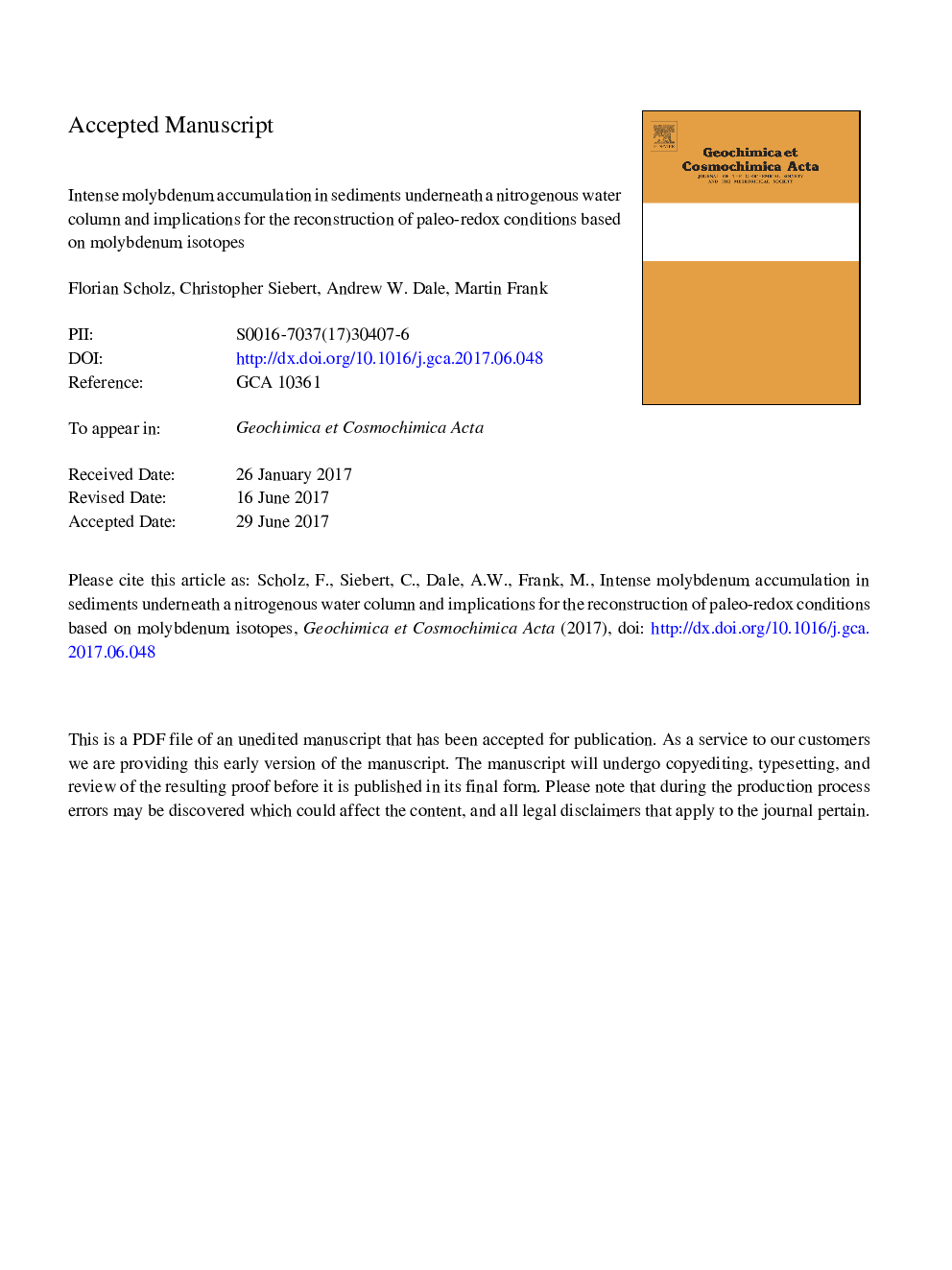| کد مقاله | کد نشریه | سال انتشار | مقاله انگلیسی | نسخه تمام متن |
|---|---|---|---|---|
| 5783340 | 1637944 | 2017 | 37 صفحه PDF | دانلود رایگان |
عنوان انگلیسی مقاله ISI
Intense molybdenum accumulation in sediments underneath a nitrogenous water column and implications for the reconstruction of paleo-redox conditions based on molybdenum isotopes
دانلود مقاله + سفارش ترجمه
دانلود مقاله ISI انگلیسی
رایگان برای ایرانیان
کلمات کلیدی
موضوعات مرتبط
مهندسی و علوم پایه
علوم زمین و سیارات
ژئوشیمی و پترولوژی
پیش نمایش صفحه اول مقاله

چکیده انگلیسی
The concentration and isotope composition of molybdenum (Mo) in sediments and sedimentary rocks are widely used proxies for anoxic conditions in the water column of paleo-marine systems. While the mechanisms leading to Mo fixation in modern restricted basins with anoxic and sulfidic (euxinic) conditions are reasonably well constrained, few studies have focused on Mo cycling in the context of open-marine anoxia. Here we present Mo data for water column particulate matter, modern surface sediments and a paleo-record covering the last 140,000 years from the Peruvian continental margin. Mo concentrations in late Holocene and Eemian (penultimate interglacial) shelf sediments off Peru range from â¼70 to 100 µg gâ1, an extent of Mo enrichment that is thought to be indicative of (and limited to) euxinic systems. To investigate if this putative anomaly could be related to the occasional occurrence of sulfidic conditions in the water column overlying the Peruvian shelf, we compared trace metal (Mo, vanadium, uranium) enrichments in particulate matter from oxic, nitrate-reducing (nitrogenous) and sulfidic water masses. Coincident enrichments of iron (Fe) (oxyhydr)oxides and Mo in the nitrogenous water column as well as co-variation of dissolved Fe and Mo in the sediment pore water suggest that Mo is delivered to the sediment surface by Fe (oxyhydr)oxides. Most of these precipitate in the anoxic-nitrogenous water column due to oxidation of sediment-derived dissolved Fe with nitrate as a terminal electron acceptor. Upon reductive dissolution in the surface sediment, a fraction of the Fe and Mo is re-precipitated through interaction with pore water sulfide. The Fe- and nitrate-dependent mechanism of Mo accumulation proposed here is supported by the sedimentary Mo isotope composition, which is consistent with Mo adsorption onto Fe (oxyhydr)oxides. Trace metal co-variation patterns as well as Mo and nitrogen isotope systematics suggest that the same mechanism of Mo delivery caused the 'anomalously' high interglacial Mo accumulation rates in the paleo-record. Our findings suggest that Fe- and nitrate-dependent Mo shuttling under nitrogenous conditions needs to be considered a possible reason for sedimentary Mo enrichments during past periods of widespread anoxia in the open ocean.
ناشر
Database: Elsevier - ScienceDirect (ساینس دایرکت)
Journal: Geochimica et Cosmochimica Acta - Volume 213, 15 September 2017, Pages 400-417
Journal: Geochimica et Cosmochimica Acta - Volume 213, 15 September 2017, Pages 400-417
نویسندگان
Florian Scholz, Christopher Siebert, Andrew W. Dale, Martin Frank,